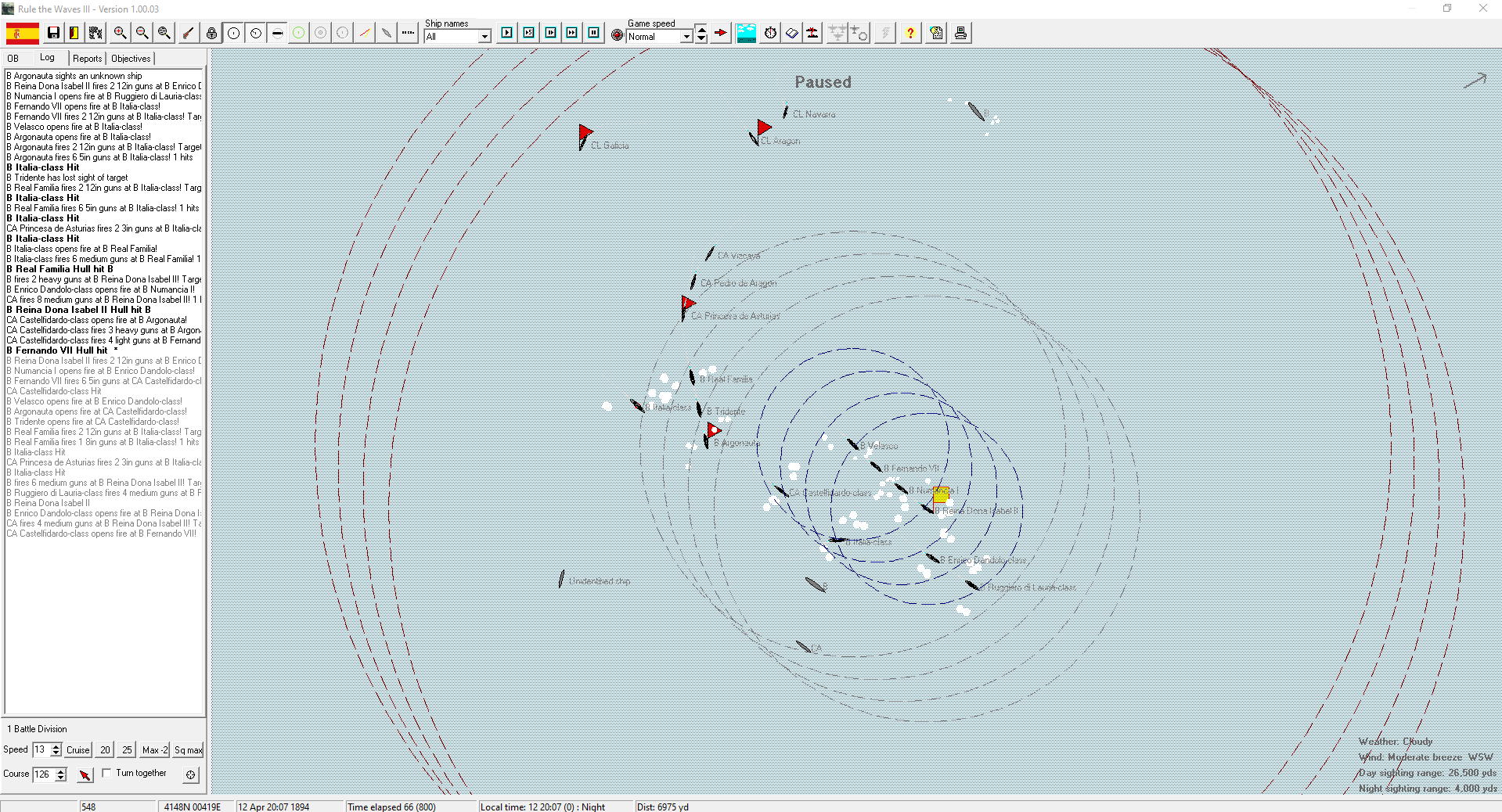Games are an often underappreciated medium for learning historical concepts, and their ability to simulate things can lend extra power. After getting your dreadnoughts torpedoed a few times in Rule the Waves, a player is likely to be far more sympathetic to Jellicoe's decision to turn away at Jutland. So in the spirit of Bret Deveraux's Teaching Paradox series, I'm going to focus in on one element that the Rule the Waves series (particularly RTW2 and RTW3) handles far better than any other game I've ever seen. Specifically, how it confronts the player with the problems of limited information and uncertainty that navies faced on almost all levels throughout the period in question.

An early night battle in RTW3
This is most visible on the tactical level. Limiting visibility to what your units could realistically see is common, but RTW brings this to the foreground. There's a button that shows the visibility circle around your currently selected unit, and it frequently changes with weather and lighting. An action on a clear day is a chess match, while a pre-radar night action is a study in paranoia and chaos that will make the player much more sympathetic to the British at Jutland. Information is also quite limited within the visible area. Ships initially appear as "unidentified ships", and over time first the type and then the specific class are revealed. But even then, this information isn't necessarily true. It will often confuse battleships and heavy cruisers or light cruisers and destroyers, and occasionally will even label a ship with the wrong class. Nor are labels preserved as visibility drops. Even if the ship was clearly identified at close range, it will become unidentified again as it reaches the fringes of visibility. The player has to learn to keep track of that, and to identify likely types of ships based on how they act in combat.
The advent of radar helps a bit with this problem, but it's far from a panacea. Early radar in particular isn't that reliable, so ships flicker in and out of visibility, and it isn't until very late in the game that radar has any ability at all to identify targets. Blips are slightly different sizes, and that and role are generally enough to give an experienced player some idea of what they're facing, but it's entirely possible to face an enemy fleet and have no clue if the battle line is some old heavy cruisers or modern battleships.
But direct visibility only applies to ships under your command.1 For every other source of information, be it an independent squadron, an air patrol, a submarine or a merchant ship under attack, the information comes in as a report, which gives strength in broad type, location and course. These are rare early on, but become common from the 20s onward as airplanes become a useful source of information. But these reports are generally pretty vague, and occasionally flat-out wrong, forcing the player to make major decisions (most notably how to allocate their air assets) in an atmosphere of deep uncertainty. Even if the strike is successful, it leaves the player with questions. The strike will generate contact reports as well as some information on what is being attacked, but unless the target is visible to the player's ships, these are exceptionally vague. The supposed target class is shown, and hits are called out, but it's not clear which ships are hit or the effects of any hits you do make. It's only once the battle ends that the player finds out how they did.

A battle in UA:D
Which isn't to say you get clear information if it is your own ships doing the shooting. This is an area where RTW varies greatly from most of its competitors. Even for your own ships, while you do see the hits you make, you don't see their effects. The game will tell you speed in 5 kt increments, if the ship is on fire, and light, medium, or heavy damage, but nothing else.2 This is almost diametrically opposite from how Ultimate Admiral: Dreadnoughts handles this, which not only calls out exactly how hits perform, but shows a graphic of how the armor of the target ship will perform against the guns being fired at it. Other games are better about this, but RTW also takes the very rare step of keeping most sinking ships on the map for a while, introducing more uncertainty and soaking up fire that might be more profitably used elsewhere.3 The player gets slightly more information about hits on their own ships, although enemy guns are just divided into light, medium and heavy and the details of damage are pretty vague.
Information flow out from the player is also limited. In the standard mode, the player can choose to take manual control of any ships that are within line of sight of the flagship, but ships outside that range are automatically under AI control, with the player just able to adjust their orders.4 For airplanes, after setting up the strike, the player has a single option to change the target area before takeoff, but after that, the planes are on their own. They'll generally attack something near the target, but there is no control over what, and that occasionally includes the player's own ships. Missiles are even worse, and will attack any ship that is along their line of flight. This can be the player's own ships, but more often means that one unfortunate ship absorbs way too many missiles, while others nearby escape undamaged.
What is particularly interesting about all of this is that the game to some extent works backwards. Navies spent the 20th century figuring out better and better ways to gather and manage information, most notably the development of plotting. An Admiral of the late 19th century would have only what he could see and the text of signals about what was going on over the horizon, and the map view the player has was revolutionary when it arrived. By WWII, a fleet commander had a staff dedicated to taking various reports and turning them into a coherent picture. While these systems are never perfect, a commander in 1970 was generally far better informed than one in 1940 or 1900. I suspect that this is largely due to gameplay constraints, as the pre-plotting version would be a very different game with different graphics, and that aside, complexity should ramp up during a playthrough. Secondarily, this also reflects the development of the series, as the basic ship combat mechanism has remained unchanged since RTW1, while the air and missile elements date to later installments.
The game also injects a lot of uncertainty into the way it handles battle setup. Instead of just smashing all available forces together, it generates battles from a set of templates representing different types of engagements, ranging from full fleet battles to convoy attacks and destroyer actions. Any ships in a given region where two warring sides are present could end up in the battle. On one hand, this is interesting and it is realistic in that the player isn't able to dictate the terms of engagement except in the broadest possible terms. On the other, the system is one of the game's weaker elements, frequently throwing out battles that make no sense and that no actual Admiral would allow to happen. For instance, it twice sent me to attack a convoy that intelligence had picked up with a couple of slow corvettes intended to keep my colonies pacified, instead of using one of several available destroyer divisions. This is a particular problem in the late game as airpower comes to dominate and the game insists on sending out small forces into areas where the enemy will dominate the skies.
The game is also somewhat unusual with its use of uncertainty on the strategic level. Most notably, research is utterly unlike the typical model most video games use. The player not only doesn't get to pick what technology is coming next, they don't even know what it is or when. All they can do is select areas for high or low priority. The game will give some hints of where the researchers are headed and when they're getting close, but these are not particularly reliable. The player might well lay down a ship, only to get a technology that would significantly improve it a few months in. RTW3 introduced several new elements along this line, too. First and most notably, while in previous installments exceeding the war threshold almost always resulted in immediate war, it is now frequent that tension stays above that limit for some time before war is declared or things settle down. Second, before the invention of radio, strategic move orders may be delayed a month or two. While the month timescale isn't a perfect reflection of...anything, movement delays were absolutely a fact of life in the 1890s.
The game leans even harder into questions of uncertainty and information in its options. One, mentioned above, restricts the player to only giving direct orders to their own flagship, regardless of line of sight. Another shuffles technology around, moving tech earlier or later and raising the possibility that things like torpedoes or multi-gun turrets will turn out not to work very well. This is deliberately intended to give the player the uncertainty faced by real navies as they dealt with changes in technology without the benefit of hindsight, although I can't really speak to this as I haven't played the game in that mode.
Overall, the Rule the Waves series does an excellent job of illustrating the uncertainty which real-world naval leaders at all levels had to deal with. This has been a consistent theme across all three titles, and I expect we will see more of it as patches come out for RTW3. For those who want some gut-level experience with information in a 20th-century naval context, it's a great way to learn.
1 It is worth pointing out that you do see everything visible to all of the ships under your command instantly, even if they are a long way from the flagship. This was very much not the case historically, but it was probably done to make gameplay enjoyable. Even with this rather major simplification, the game still gets the message across. ⇑
2 Well, sort of. You can zoom in and see the conditions of the turrets if you've identified the ship. That's how I found out it isn't always right about the labeled ship class. ⇑
3 This occasionally results in tons of fire being directed at a ship which is obviously sinking, and the game could really use a "not a target any more" button. ⇑
4 There's another mode which only lets the player control the flag division, period. ⇑

Comments
So, any plans to run a RTW3 campaign here, like you previously did with RTW2?
No, because the reasons it died off haven't changed. There's a lot of information that needs to go in the posts for people to be able to make intelligent decisions, and getting that together was enough work that it was rapidly becoming not fun. And one of my cardinal rules is to try and avoid things that are not fun. I'd like to in theory, but don't see the writeups becoming feasible again any time soon. I'd consider at doing more with it if I can figure out something that doesn't take as much effort on my part, but I don't know what that looks like that yet.